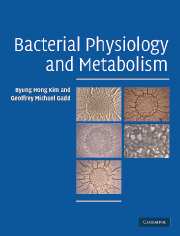Book contents
- Frontmatter
- Contents
- Preface
- 1 Introduction to bacterial physiology and metabolism
- 2 Composition and structure of prokaryotic cells
- 3 Membrane transport – nutrient uptake and protein excretion
- 4 Glycolysis
- 5 Tricarboxylic acid (TCA) cycle, electron transport and oxidative phosphorylation
- 6 Biosynthesis and microbial growth
- 7 Heterotrophic metabolism on substrates other than glucose
- 8 Anaerobic fermentation
- 9 Anaerobic respiration
- 10 Chemolithotrophy
- 11 Photosynthesis
- 12 Metabolic regulation
- 13 Energy, environment and microbial survival
- Index
- References
7 - Heterotrophic metabolism on substrates other than glucose
Published online by Cambridge University Press: 05 September 2012
- Frontmatter
- Contents
- Preface
- 1 Introduction to bacterial physiology and metabolism
- 2 Composition and structure of prokaryotic cells
- 3 Membrane transport – nutrient uptake and protein excretion
- 4 Glycolysis
- 5 Tricarboxylic acid (TCA) cycle, electron transport and oxidative phosphorylation
- 6 Biosynthesis and microbial growth
- 7 Heterotrophic metabolism on substrates other than glucose
- 8 Anaerobic fermentation
- 9 Anaerobic respiration
- 10 Chemolithotrophy
- 11 Photosynthesis
- 12 Metabolic regulation
- 13 Energy, environment and microbial survival
- Index
- References
Summary
It has been described previously how glucose and mineral salts can support the growth of certain heterotrophs. In this case, the organisms obtain ATP, NADPH and carbon skeletons for biosynthesis through central metabolism. Almost all natural organic compounds can be utilized through microbial metabolism. In this chapter, the bacterial metabolism of organic compounds other than glucose is discussed. Since central metabolism is reversible in one way or another, it can be assumed that an organism can use a compound if that compound is converted to intermediates of central metabolism. Some bacteria can use an extensive variety of organic compounds as sole carbon and energy sources, while some organisms can only use limited numbers of organic compounds; for example, Bacillus fastidiosus can use only urate.
Hydrolysis of polymers
Plant and animal cells consist mainly of polymers. They include polysaccharides, such as starch and cellulose, as well as proteins, nucleic acids, and many others. Such polymers cannot be easily transported into microbial cells but are first hydrolyzed to monomers or oligomers by extracellular enzymes before being transported into the cell.
Starch hydrolysis
Starch is a glucose polymer consisting of amylose and amylopectin. The former has a straight chain structure with α-1,4-glucoside bonds, while the latter has side chains with α-1,6-glucoside bonds. Starch is the commonest storage material in plants, and many prokaryotes produce amylase to utilize it as their energy and carbon source.
- Type
- Chapter
- Information
- Bacterial Physiology and Metabolism , pp. 202 - 251Publisher: Cambridge University PressPrint publication year: 2008
References
- 1
- Cited by



